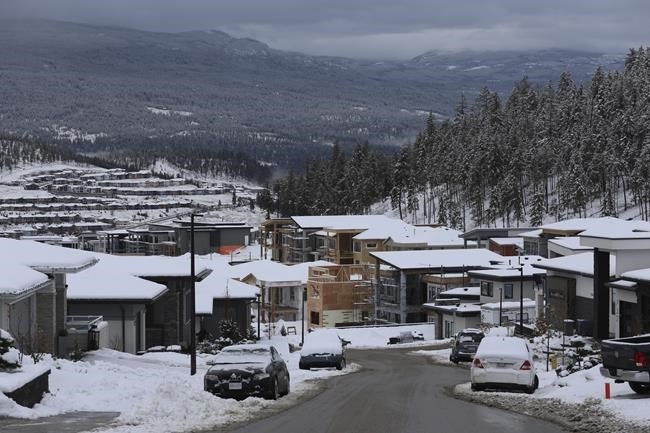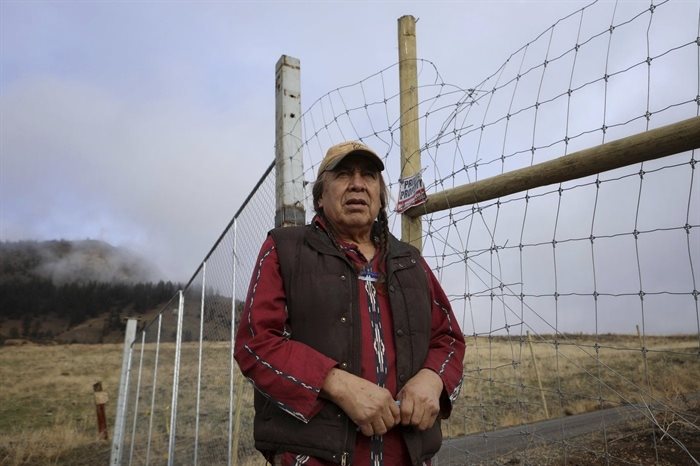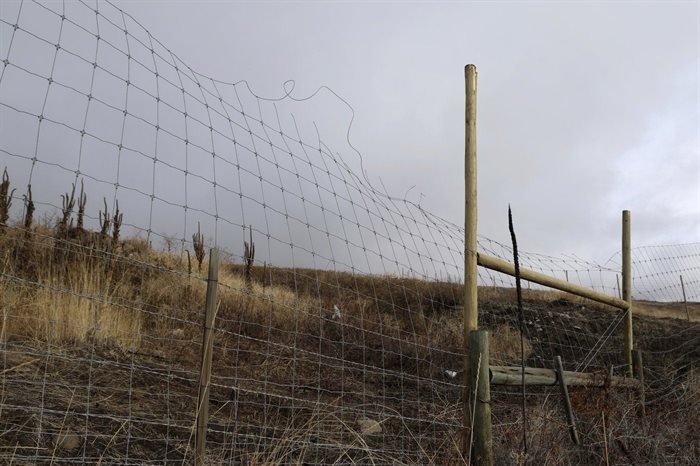iN PHOTOS: Orchard expansion in Okanagan stirs fears a key wildlife corridor will be harmed

KELOWNA, British Columbia (AP) — Just below the fog line hanging over the central Okanagan Valley, rows of saplings for a cherry orchard expansion span the eastern stretch above Highway 33 on the outskirts of Kelowna in Canada's wine country.
New cherry varieties and climate change in British Columbia's interior have enabled the fruit to grow at higher than usual elevations. Soon, this grassland terrain surrounded by mountains of ponderosa pine will be full of rows of cherry trees along a sloping hill above this city of about 145,000.
On a recent morning, Dixon Terbasket of the Lower Similkameen Indian Band arrived at the gate of a 10-foot (3 meter) high fence built last year. He gestured at a private property sign hanging from the fence on his ancestral homeland — a barrier to keep a soon-to-be-blossoming orchard free from mule deer and elk that once traversed this patch of land.
“The amount of development that’s happening so quickly and rapidly … the urban sprawl is moving out into the wilderness part of it,” said Terbasket, a wildlife technician with the Okanagan Nation Alliance.
The syilx Okanagan are Indigenous people who have inhabited the Okanagan Valley in the interior of B.C. for thousands of years. Their governing body, the Okanagan Nation Alliance, represents eight member communities, including the Lower Similkameen Indian Band.
The orchard expansion is approximately one-third of a mile (.6 kilometers) away from a wildlife corridor that acts as a crucial link for at-risk species moving through the region's natural areas, from south of the border in Washington state into the province’s dry interior.
While not immediately infiltrating the corridor, this new orchard has heightened concerns development is bleeding farther into the valley’s natural territory. Terbasket and other experts worry man-made barriers are already hurting the corridor's habitat connectivity, further threatening at-risk species and jeopardizing the area’s biodiversity.
“Animals have to move through landscapes to meet their life history demands,” said Adam Ford, an associate professor in the department of biology at the University of British Columbia-Okanagan and the Canada Research Chair in Wildlife Restoration Ecology.
“So much of the land has already been degraded," Ford said. "We’re hanging on to the last green ribbons around our highly developed landscapes, and that’s especially true in the Okanagan where we have so much pressure from urbanization and agriculture.”
Home to more than 180 licensed grape wineries and known as “the wine capital of Canada,” the Okanagan Valley is also nationally renowned for fruit orchards that produce apples, peaches and cherries.
According to provincial documents, the cherry orchard expansion — approximately 343 acres (139 hectares) — is on land owned by G.P. Sandher Holdings Ltd., which represents Sandher Fruit Packers, a local family-owned business.
While parts of the corridor are in Kelowna’s eastern city limits, this orchard parcel falls within the Regional District of Central Okanagan. A significant portion of the corridor — including this parcel — is within B.C.’s Agricultural Land Reserve, where farming is allowed under the provincial Right to Farm Act.
“The conflict you’re going to find is between the right to farm in agricultural land, and the protection of this corridor,” said Dean Strachan, manager of community planning and development for the City of Kelowna.
“The cherry orchard, under the Agricultural Land Commission’s permits, have the ability to build high fences to protect their orchards from deer. But not only deer are restricted from the land, as a result.”
Sandher Fruit Packers declined to comment.
Kelowna is one of Canada's fastest growing cities, increasing from 127,380 residents in 2016 to 144,576 in 2021, according to the city. Recognizing the population growth, its 2040 official community plan — adopted in 2022 — calls for slowing down urban sprawl to protect agricultural lands and ecologically sensitive areas.
Ribboning around Kelowna between two provincial parks — the Okanagan Mountain Provincial Park and Kalamalka Lake Provincial Park — the wildlife corridor is about 40 miles (64 kilometers) long and six-tenths of a mile (1 kilometer) wide.
It’s traveled by wildlife such as elk, moose, mule deer, white tailed deer and badgers — and grizzly bears have been spotted. The corridor is home to other animals and berries, plants and medicines used by First Nations peoples.
“For the grasslands all the way into the interior of B.C., this is a major pinch point,” said Scott Boswell of Okanagan Collaborative Conservation Program, the organization spearheading a protection plan for the corridor along with the Okanagan Nation Alliance.
“This is a top range of this ecosystem," Boswell said.
The corridor was identified as a place needing protection because of its unique ecosystem. Though outside its boundaries, the corridor runs adjacent to the Yellowstone to Yukon Conservation Initiative, a cross-border partnership dedicated to protecting habitats along the spine of the Rocky Mountains.
The Kelowna corridor is more closely located to the Sagelands Heritage Program's cross-border conservation effort dedicated to shrub-steppe landscapes in the Okanagan Valley to south-central Washington.
“Ecosystems — if we want them to be healthy and resilient at the very highest level — they need to be connected,” said Sarah Hechtenthal, an ecosystem scientist with Parks Canada and lead scientist with its National Program for Ecological Corridors.
The Kelowna area and surrounding Okanagan Valley were identified by Parks Canada as one of 23 priority areas in the country with a “significant need for connectivity conservation.”
Hechtenthal noted the area has more rare threatened and endangered species than anywhere else in the province. This includes badgers, burrowing owls, western rattlesnakes and dozens of others.
“The priority areas in this region are really under intense anthropogenic development pressure, and are being fragmented; degraded; lost to agriculture development, resource extraction and urban sprawl,” she said.
The orchard site is just outside Kelowna on land owned by the Regional District of Central Okanagan.
The agency said residents and neighboring communities raised concerns regarding soil movement, drainage and noise in the past. Another agency, the provincial Ministry of Forests, said it was investigating whether the orchard project piped water from an unpermitted source, but declined further comment.
While the current orchard expansion is outside the wildlife corridor, Brittany Nichols, the regional agency's manager of development services, said Sandher “retains ownership of additional land extending into portions” of the corridor. She said an environmental assessment in the orchard's development permit proposal outlines the company's commitment to “environmental monitoring.”
Feeling pressure of human development on wildlife, the corridor’s health and connectivity, the Okanagan Nation Alliance, Okanagan Collaborative Conservation Program and their partners put together a Wildlife Corridor Action Plan finalized last year.
Fifteen actions — informed by tribal hunters and knowledge keepers — in the five-year plan are centered around their laws, principles and protocols. The plan is still in infancy, and Boswell said groups involved are looking to get funding from the province and foundations.
“We’re not just talking about moose, we’re talking about a whole ecological system that filters our water, filters our air, that provides pollinators for all of our agriculture,” he said.
“It’s a bigger picture than just one species.”
EDITOR’S NOTE: This story is a collaboration between The Associated Press and IndigiNews.
Aaron Hemens is a staff reporter and photographer at IndigiNews, an online Indigenous-led publication in British Columbia.
Associated Press climate and environmental coverage receives support from several private foundations. See more about AP’s climate initiative here. The AP is solely responsible for all content.






